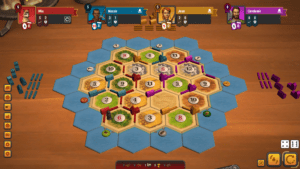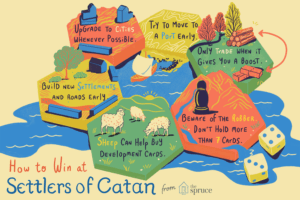For this critical play, I played Settlers of Catan. It is a resource based board game created by Klaus Teuber and can be played with 3-4 players (in the standard version). The premise of the game, as the title implies, is to build roads and settlements on the map via acquired and maintained resources. Players start off by putting two settlements and roads (one at a time in a snake fashion) to determine the initial starting point of the game. Settlements are placed on the intersection of tiles where each tile has a number and resource associated with it. Then, at each turn, players roll two dice to generate a number and players with a settlement touching a tile with that number are able to retrieve the corresponding resource. The five resource cards are brick, lumber, wool, grain, and ore, and are all used in order to build things such as roads, settlements, cities, buy development cards, or use in trading. The first person to 10 points wins and can be achieved through a combination of enough settlements/cities and special actions like “longest road”.

Overall, game balance is crucial to the enjoyment of this game. I liked that there was no single way to win but that each winning strategy was completely dependent on the initial game board or the strategies of others. For example, one strategy that I saw was someone trying to completely “eliminate” a resource so that they could hoard it and thus deplete it from other people. Another possible strategy that I saw was loading up on brick and lumber (which are used for roads) in order to expand early and to achieve the “longest road” attribute (and then trade in an excess of those resources later for others). Apart from individual strategies, the game allows for interaction with other players. In particular, the game allows for many opportunities for trading and it was interesting to see that the trading mechanic truly allowed players to truly benefit from trade. I personally had built several ports (which allowed for cheaper trading with the “bank”) and liked that I was given the ability to not be completely resource constrained by other players or the board as well.

Looking back, I think that my primary flaw was the placement of my initial settlements. I placed mine too close to the edges and was unable to build inwards since the other players took those spots afterwards. I additionally was lacking brick in the early rounds and it was difficult to both build in or block other players from building. However, it might be a one-time bias for my specific game since the player with the longest road ended up winning in my game.


